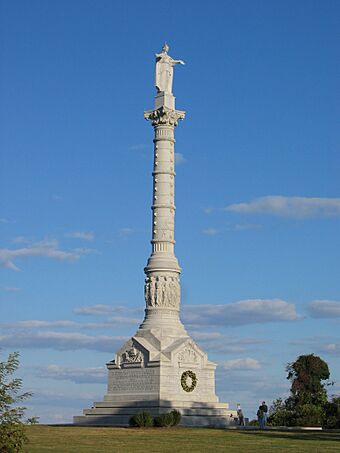Colonial National Historical Park facts for kids
|
Colonial National Historical Park
|
|
|
Former U.S. National Monument
|
|

Yorktown Victory Monument near Yorktown, Virginia
|
|
| Location | York and James City counties and Williamsburg, Virginia |
|---|---|
| Nearest city | Williamsburg, VA |
| Area | 9,349.28 acres (3,783.52 ha) 9,271.30 acres (3,751.96 ha) federal |
| Built | 1607 |
| Architect | Peterson, Charles; et al. |
| Architectural style | Colonial Revival |
| Visitation | 2,762,273 (2022) |
| Website | Colonial National Historical Park |
| NRHP reference No. | 66000839 |
Quick facts for kids Significant dates |
|
| Added to NRHP | October 15, 1966 |
| Designated NMON | December 30, 1930 |
| Designated NHP | June 5, 1936 |
The Colonial National Historical Park is a big national park in Virginia. It's managed by the National Park Service. This park helps protect and explain important places from the early days of the Colony of Virginia and the history of the United States. You can find everything from the very first English settlement at Jamestown to the battlefields of Yorktown. This is where the British Army lost a major battle in the American Revolutionary War. More than 2.7 million people visited the park in 2022.
Contents
Exploring the Park's Special Places
The Colonial Parkway: A Scenic Drive
The park includes the Colonial Parkway. This is a beautiful 23-mile (37 km) road that connects three important historical spots in Virginia. These spots are Jamestown, Yorktown, and Colonial Williamsburg. The parkway goes through James City County, York County, and the city of Williamsburg.
Jamestown: Where English America Began
The park protects the original site of Jamestown. Today, this area is known as Historic Jamestowne. It's located in James City County at the southern end of the Colonial Parkway. This part of the park includes Jamestown Island and the Jamestown Glasshouse. Right next to it is Jamestown Settlement, another attraction run by the state of Virginia.
Yorktown Battlefield: A Turning Point in History
The park also manages the Yorktown Battlefield. This historic site is at the eastern end of the Colonial Parkway in York County. The Thomas Nelson House was built around 1724. It was used as the headquarters for General Cornwallis during the final battle of the Revolutionary War.
This battlefield was where the British Army was defeated. Both the house and the old siege earthworks (defensive walls made of earth) were fixed up in 1976. The Moore House is also in the park. This is where the surrender talks happened in 1781.
Green Spring Plantation: An Early Experiment
William Berkeley was a colonial governor of Virginia for a very long time. He used his Green Spring Plantation as a special farm. Here, he tried to find new ways for the colony to make money. He wanted to find other sources of income besides growing tobacco and trading furs.
Cape Henry Memorial: The First Landing
The Cape Henry Memorial marks the spot where Captain Christopher Newport and the Jamestown colonists first landed in 1607. It's located in Virginia Beach, Virginia at Cape Henry. This memorial is open to visitors and is found on the Navy's Joint Expeditionary Base East.
How the Park Was Created
The Colonial National Monument was officially approved on July 3, 1930. It was then established on December 30, 1930. Later, on June 5, 1936, it was renamed a National Historical Park. The cemetery at Yorktown was moved from the War Department to the National Park Service on August 10, 1933.
Historic Jamestowne is partly owned by the National Park Service and partly by Preservation Virginia. The National Park Service manages the entire site. Preservation Virginia owns 22 acres (89,000 m²) where the remains of the original 1607 fort are found. The National Park Service owns the other 1,178 acres (4.77 km²) of the island. This larger area contains the remains of the expanded town and its old plantation sites.
Both the Colonial National Historical Park and Jamestown National Historic Site are listed on the National Register of Historic Places. This is a list of important historical places in the U.S.
Images for kids
-
Yorktown Victory Monument near Yorktown, Virginia




